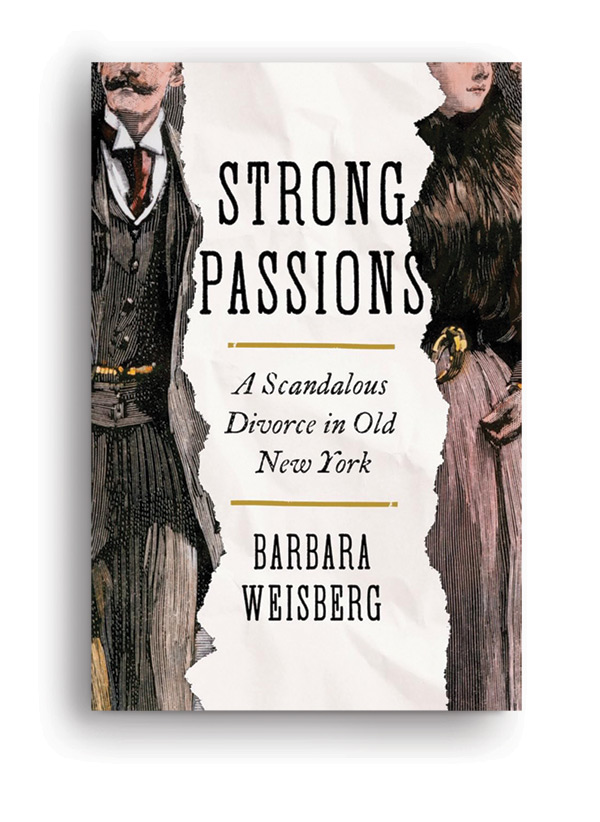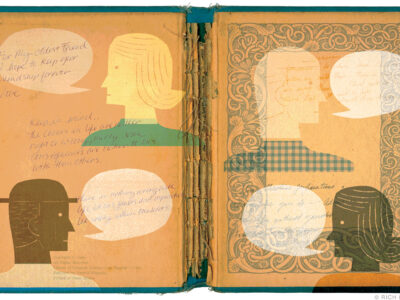A tumultuous 19th-century divorce trial spotlighting adultery and abortion opens a window on social shifts roiling post-Civil War America.
By Julia M. Klein

A Scandalous Divorce
in Old New York
By Barbara Weisberg CW’68
W. W. Norton & Company, 336 pages, $28.99
In late 1865, in the immediate aftermath of the Civil War, a less sanguinary battle was exposing the unseemly underbelly of a New York high-society marriage. But the combatants in the Mary and Peter Strong divorce case were not just tabloid-worthy. The volley of charges they exchanged in the courtroom involved issues—marital roles, adultery, abortion, child custody—that still resonate today.
Such is the premise of Barbara Weisberg CW’68’s cleverly titled book, Strong Passions: A Scandalous Divorce in Old New York, published in February. “The Strongs’ divorce demonstrated to a society at war with itself that the ‘perfect union’ was as much a fiction in marriage as it had proved to be for the nation, an analogy that did not escape Americans at the time,” Weisberg writes.
Hailing from socially elite, moneyed families, both Mary Stevens and Peter Strong initially seemed well-matched. But the marriage grew strained, and after the death of their youngest child Mary confessed to having an affair with Peter’s brother Edward. She was pregnant at the time. She later charged that her husband not only compelled her to have an abortion, but had an affair with the abortionist. It was, for the mid-19th century, an uncommonly steamy brew of the illegal and the transgressive.
For the estranged Strongs, divorce seemed inevitable. But it was difficult to obtain. Divorce in 1860s New York required a finding of adultery. And if both spouses were deemed to have been adulterous, Weisberg observes, no divorce could be granted. Custody arrangements generally favored the father. But prior to the trial Mary had absconded with the younger of their two daughters, and her whereabouts remained unknown.
The Strongs “encompassed and were a vehicle for discussing so many stories that touched women’s lives,” Weisberg says. “But, also, the characters seemed to me to prefigure a lot of our great 19th-century literature,” including the novels of Henry James and Edith Wharton, who was a younger cousin of Mary Strong. The complicated web of adultery and betrayal in the Strong case was “the kind of raw material they worked with.”
Drawing on newspapers, family letters, diaries, and other archival sources, Weisberg recreates both the historical backdrop of the Strong marriage and its aftermath. But the book’s centerpiece is an intimate daily chronicle of the divorce case, as well as Peter Strong’s earlier manslaughter trial for allegedly forcing his wife to have an abortion. The trials offered, Weisberg writes, “a series of overlapping narratives,” with clashing perspectives and disputed facts.
In a starred review, Publishers Weekly called Strong Passions “a page-turning glimpse into the lives of 19th-century New York’s upper crust.” The 19th century is familiar territory for Weisberg, an American Civilization major at Penn. She covered the same time period in her 2004 biography Talking to the Dead: Kate and Maggie Fox and the Rise of Spiritualism [“Briefly Noted,” Jan|Feb 2005].
A poet who studied with Allen Ginsberg, Weisberg also has published four books for children and young adults. A former television producer, she cocreated the 1980s sitcom Charles in Charge. She lives in upstate New York with her husband, David Black, a journalist, author, and screenwriter.
Weisberg stumbled on the Strong story while researching the Fox biography, when she encountered the diary of Peter Strong’s lawyer cousin George Templeton Strong at the New-York Historical Society. “I consider him the American Samuel Pepys,” she says, referring to the celebrated 17th-century British diarist. In Strong Passions, she calls the journal “an extraordinary window into New York life.”
Her initial idea was to write a biography of George Strong. But in reading the diary, she “came across the tragedy of his cousin [Peter],” Weisberg says. “For a number of years, I would dip in and out of that material, until I felt like I was almost living with those people.” Waylaid at times by other projects, she spent about a decade completing Strong Passions.
A quotation from an Edith Wharton short story serves as an epigraph to the introduction and suggests one of the book’s takeaways. “Was not all morality based on a convention?” Wharton wrote. “What was the staunchest code of ethics but a trunk with a series of false bottoms?”
In other words, morality is mutable. “We talk about issues of family life being embedded either in the Constitution or in the Bible or in natural law,” Weisberg says. “And when you look at how these things have boomeranged back and forth, you realize that that simply can’t be the foundation of these arguments.”
One convention that was starting to gain acceptance at the time of the Strong trial, Weisberg says, was the notion of using “the best interests of the child” to determine custody arrangements. Other social norms, too, seemed to be shifting. Both adultery and abortion were still illegal, though rarely punished. And it was “a time of significant confusion and transition in the relationship between men and women,” Weisberg writes.
Both Talking to the Dead and Strong Passions entailed unsolved mysteries. In the case of the Strongs, Weisberg says, “what most intrigues me is why, in heaven’s name, did Mary go off and have an affair with her brother-in-law?” In his diary, George Strong had called her “straitlaced & stately.” Weisberg speculates that Mary, accustomed to the bustle of the city, might not have enjoyed living in then-rural Queens with Peter’s family. “She probably was strong-willed, and not thrilled about that.”
Edward, a widower, was living in the same house. Weisberg raises the claim, made at trial, that the relationship might have involved coercion. “Was it a love affair?” she wonders. “Or did Edward exert pressure on her?”
Peter was acquitted of manslaughter in the earlier trial after the prosecution unaccountably failed to subpoena a key witness. It remains unclear whether he ever had a sexual relationship with Electa Potter, the alleged abortion doctor. Weisberg doubts it, and the jury in the Strong case could not agree. Only two jurors were convinced of the affair, while all 12 found Mary guilty of adultery.
The hung jury on Mary’s countersuit left the Strongs married, however unhappily. It took private negotiations and a decision by a court-appointed referee to finally secure their divorce.
“It’s not possible really to do more than speculate on some of these mysteries, which is what I do,” Weisberg says. “There are many possible interpretations of what is going on in this story,” and those “elements of unknowability … captured my attention.” Readers are left to draw their own conclusions.




